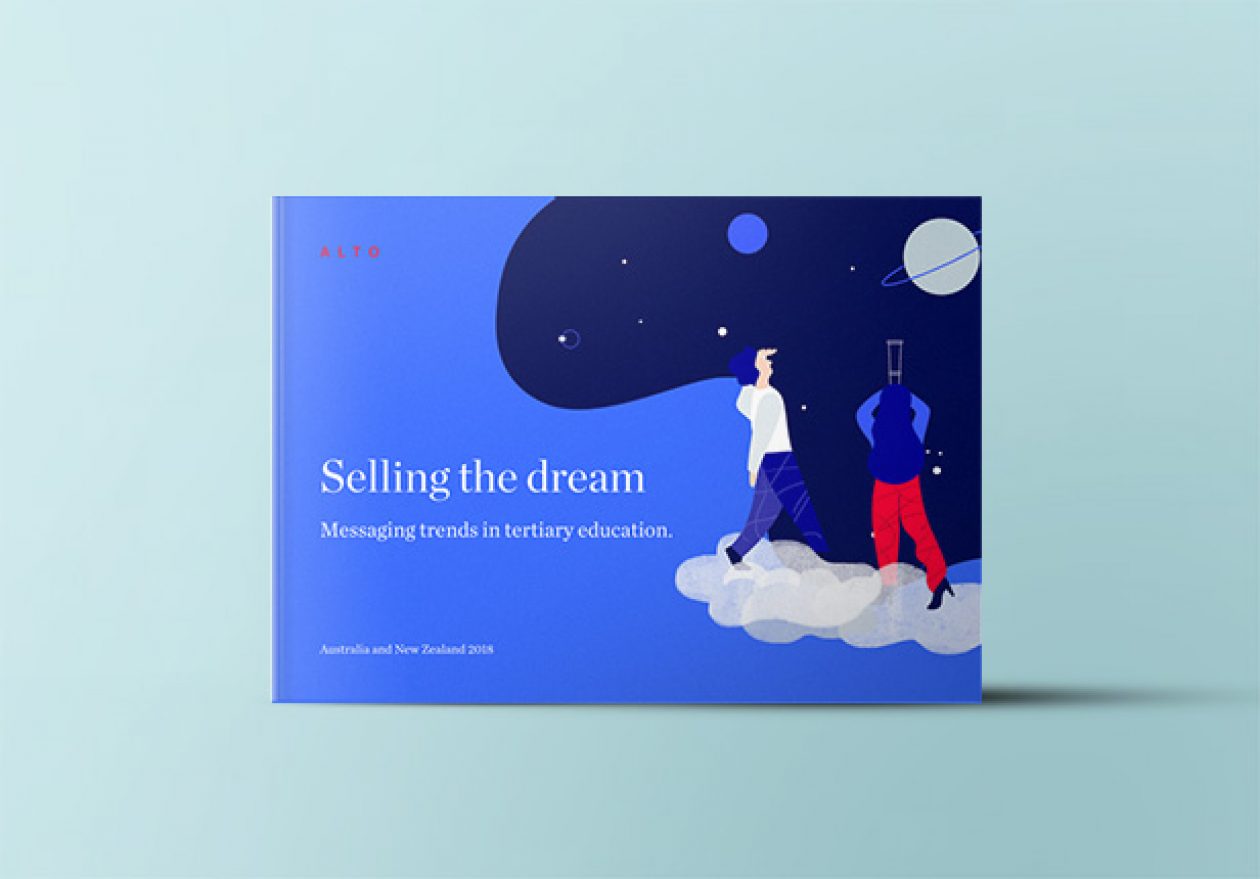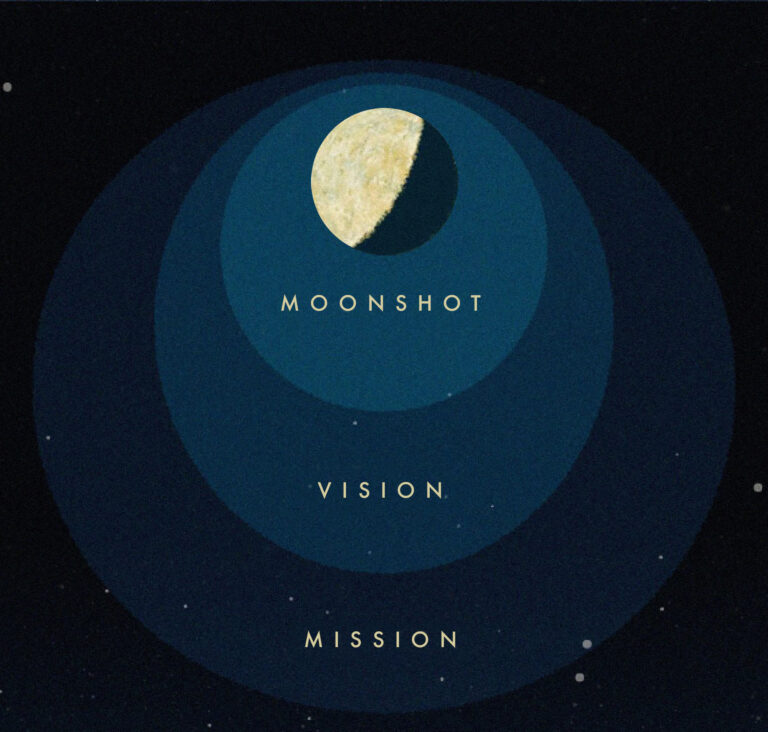A large chunk of our tertiary education providers seem stuck in brand messaging no man’s land.
It’s time we start exploring new territories and alternative approaches in order to differentiate our tertiary education brands in the minds of prospective students.
Instead of continuing the struggle to be everything to everybody – let’s start being something to somebody.
We recently explored how tertiary education brands across Australia and New Zealand are talking to their potential audiences. It was found that very few providers have a unique or differentiated brand message. In fact all brand positioning statements and campaign marketing messages could be grouped into eight categories. Download ‘Selling the dream’ to find out more.
This means a large chunk of our tertiary education providers are stuck in messaging no man’s land. Yet they continue to spend big on extravagant advertising campaigns that are for the most part undifferentiated, non-targeted and very expensive.
“In terms of cost per student – marketing budgets can range from the sublime to the ridiculous with the highest spending institution allocated $561 for every student enrolled” – reported Julie Hare in her 2013 article published in the The Australian.
To me this traditional blanket message approach to advertising seems a bit fruitless, and often these high-level brand messaging campaigns are not much more than brand name puffery. Perhaps it’s time to start exploring some alternative approaches.
We are at a point in time where marketing has the ability to target specific consumers directly via digital means across an array of channels. There are a swag of tools available to measure the reach and impact. There are platforms available to have engaged conversations with specific communities that want to listen. I would argue that the time and money used to create these mega ‘high-level’ brand messaging campaigns would be better spent on targeting smaller, more niche audiences with messages that are meaningful and content that is helpful.
It’s no doubt that brand and marketing departments in larger educational institutions have their work cut out for them. It’s tough out there. It’s an increasingly competitive market under threat from disruption both locally and globally. So exploring new territories and ways to go about differentiating their brands from their nearest known or unknown competitors should be at the top of their list of priorities.
Stop being everything to everybody.
Here’s where the problem lies. Institutions that offer a broad range of courses across multiple disciplines and industry categories will always struggle to find a core, differentiated brand message that resonates on a personal level to their audience. It’s almost impossible. Why? Because you can’t be everything to everybody. A brand trying to be everything to everybody quickly undermines what makes them uniquely different.
In an industry like education where there is a vast ocean of existing similar offerings and new specialised alternatives arriving daily. To compete you must be uniquely different.
However, being uniquely different doesn’t mean setting sail for an unoccupied coordinate on a market positioning map. You know those charts where the Y axis has something like conservative to progressive mapped on it. While the X axis is economy to premium or similar. And there’s a whole bunch of logos scattered along the axis representing the pesky competition. You analyse the chart, look for a clearing and bang – there it is! The sweet spot. That gap in the market unoccupied by any of the competitors and most certainly where all the untapped opportunity lies.
We’ve witnessed an attempted brand differentiation ‘strategy’ very similar to above and needless to say that ship quickly sunk.
Start being meaningfully different.
It’s not about just being different—anyone can position themselves differently to their competitors, but if that difference is not relevant to a specific audience, well then that strategy is going to sink.
It’s about being ‘meaningfully different’. The real task is in finding — or re-discovering — the unique qualities that separate your offering from the sea of competitors and connecting it to a specific group of individuals in a way that is meaningful and authentic. Time spent working towards creating a meaningfully differentiated positioning and brand will be much more memorable in the mind of the consumer and have longer lasting effects.
So if tertiary education brands are to stop trying to be everything to everybody, they must start being something to somebody. The next logical step in this change of strategy is to identify who they truly are for. In the case of educational providers we can split the competitive playing field into two. This applies across both traditional ‘bricks and mortar’ institutions and online providers.
- Multidisciplinary providers: those who offer a number of courses across multiple industries and/or disciplines.
- Specialist providers: those who specialise in a specific industry sector and/or specific set of disciplines.
If we look at the role of brand and marketing through these two lenses it could be said that the specialist providers have a unique advantage over their more generalist counterparts. They know exactly who they are for. By knowing and identifying with their target audience they have the opportunity to leverage this intimate relationship by tailoring brand messaging to connect directly to their needs. This makes their quest for a unique point of differentiation a little easier.
For multidisciplinary providers – pinning down a specific target audience can be a bit like trying to catch smoke in your mouth.
House of brands or branded house?
Perhaps multidisciplinary providers could benefit from thinking more like specialists. All multidisciplinary providers are bound to have number of industry category specialisations – Arts, Sciences, Design etc. Rather than creating generalist high-level brand messaging as an attempt to catch all, institutes could spend more time and effort creating strategically focused category or faculty level sub-brands. Sub-brands that campaign around a faculty’s unique industry specialisation as a strong point of difference. Pair this with a marketing strategy that connects and resonates with a specific audience on a personal level – then we may have a recipe for success.
Let’s explore this concept. Take a science department for example. Science doesn’t normally conjure up the sexiest of mental images for most. People in white coats spending hours in quiet, sterile labs solving complex equations… yawn. It would be safe to say that science has an image problem and as result is not often featured on the frontline of most institutional marketing or advertising efforts. It’s more likely stuck on the back bunsen burner.
What if we could reimagine that stereotypical image and shift some perceptions? Flip the stereotypes around to engage, inspire and attract the next generation of Australian scientists. Just think – Scientists dissect and discover, explode and explore, investigate and invent. Their work can genuinely change the world. How cool is that? Cool enough for the Monash Science department to launch a faculty-level campaign to bust some of the common myths that exist around science-related careers, and inspire the next generation of young scientists.
This example illustrates that there is great potential for departments to connect directly to their desired audience on a much more personal level. To flex their own unique identity and strengths, have some fun and make an impact.
Discover a unique point of difference, for a unique audience.
In the report Higher education and the power of choice professional services firm Ernst & Young identified that a clearly differentiated brand position was the key to surviving and thriving. Institutions “should consider strategies and techniques used in consumer marketing industries, for example, the creation of focused market positions based on the principles of psychographic segmentation, and multi-brand strategies, which could enable universities to serve multiple segments without diluting their core brand.”
So if we consider the above advice and start to think of students more like consumers – let’s look at how we go about discovering a unique selling proposition for customers in a consumer market.
Define the audience:
First step is to identify who you are talking to – and it’s not everybody : ) Prospective students, existing students, industry partners, internal staff? Start the process by focusing on one specific segment only. If it helps, focus on a small subset of this group. It could even be a type of mindset rather than a specific demographic or persona type.
Empathise with your audience. What are their challenges? What are their needs and wants? What do they think, feel and do? There are plenty of online tools and templates out there to help ’empathy map’ a customer. Don’t stop at just one customer type – go wide – go deep.
Uncover a differentiated proposition:
Value proposition: What is the single most important thing you do for this customer type?
Benefit: What problem does this help them solve, and how will this make their lives easier or better?
Validate the market:
Relevant: Is there an unmet need for this in your market category?
Unique: Can you own this space? Are you one of the first here?
Get internal acceptance:
Authentic: Is it truthful? Can you and your team, department or faculty deliver on this promise?
This last one is super important. Once you commence the quest for differentiation the real job is winning the hearts and minds of the most important ambassadors – the internal team. Everyone needs to believe the hype and be onboard the brand ship when it sets sail, not just fed the branded cupcakes on the day that the campaign launches. If you’re going to get everyone onboard, the movement has to start from the inside. If it connects on the inside then it will resonate on the outside.
…
Finding — or re-discovering — the unique qualities that separate your offering from the sea of competitors, and aligning these to a specific audience is key in successful brand differentiation. Get this sorted then you’re well on your way to building the solid foundations for a meaningful point of differentiation. Next part is creating an authentic brand story to carry this message to the masses in a way that will connect, inform and inspire action.
You’ve got to know the rules before you can break them.
Find out what they are in our report, available now. Download your free copy.








